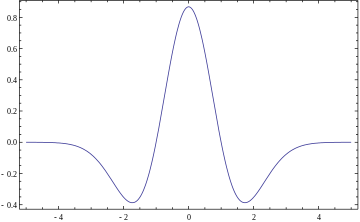Mexican hat wavelet

In mathematics and numerical analysis, the Ricker wavelet[1]
is the negative normalized second derivative of a Gaussian function, i.e., up to scale and normalization, the second Hermite function. It is a special case of the family of continuous wavelets (wavelets used in a continuous wavelet transform) known as Hermitian wavelets. The Ricker wavelet is frequently employed to model seismic data, and as a broad spectrum source term in computational electrodynamics. It is usually only referred to as the Mexican hat wavelet in the Americas, due to taking the shape of a sombrero when used as a 2D image processing kernel. It is also known as the Marr wavelet for David Marr.[2][3]

The multidimensional generalization of this wavelet is called the Laplacian of Gaussian function. In practice, this wavelet is sometimes approximated by the difference of Gaussians function, because it is separable[4] and can therefore save considerable computation time in two or more dimensions. The scale normalised Laplacian (in  -norm) is frequently used as a blob detector and for automatic scale selection in computer vision applications; see Laplacian of Gaussian and scale space. The Mexican hat wavelet can also be approximated by derivatives of Cardinal B-Splines[5]
-norm) is frequently used as a blob detector and for automatic scale selection in computer vision applications; see Laplacian of Gaussian and scale space. The Mexican hat wavelet can also be approximated by derivatives of Cardinal B-Splines[5]
References
- ↑ http://74.3.176.63/publications/recorder/1994/09sep/sep94-choice-of-wavelets.pdf
- ↑ http://www2.isye.gatech.edu/~brani/isyebayes/bank/handout20.pdf
- ↑ http://cxc.harvard.edu/ciao/download/doc/detect_manual/wav_theory.html#wav_theory_mh
- ↑ Fisher, Perkins, Walker and Wolfart. "Spatial Filters - Gaussian Smoothing". Retrieved 23 February 2014.
- ↑ Brinks R: On the convergence of derivatives of B-splines to derivatives of the Gaussian function, Comp. Appl. Math., 27, 1, 2008

